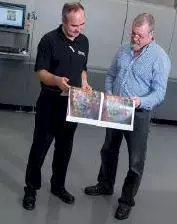Parents know this refrain well, “Are we there yet?” just as they know the answer: “In a little while.” I spend my working life with printing technology and have heard this for many years. In the case of inkjet, this is a recurring theme. And while we are not there yet, we are getting much closer.
Some print providers have arrived. A great example is REAL Digital International based in South London. In 2004, the company was founded based on the belief that transactional and direct mail production could be improved using a flexible inkjet solution. They invested heavily in secure premises and powerful workflow with finishing systems to cut, fold, collate and insert almost anything. They invented 650mm wide high quality colour duplex web inkjet printing by mounting a pair of single pass inkjet presses on a flexible transport system. Further, REAL Digital International developed new paper coatings to reach acceptable quality for leading brands, printing personalised carriers, mailers and magazines. They identified inkjet’s potential and went for it, making good money in the process.
“Inkjet technology provided the flexibility, enabling us to deliver solutions that address latent customer demand and to drive new demand in areas where we have seen further opportunities. The technology continues to evolve, and inks are more flexible with increased colour gamut, reducing the need for special substrates whilst increasing productivity,” says David Laybourne, managing director, REAL Digital International. “As the ink manufacturers accept more viable pricing models, the proportion of the marketplace that inkjet solutions are able to address will only increase.”
Viable ink costs are keys
Laybourne’s opinion about viable ink pricing models is informative. Ink cost makes medium to long runs with high ink coverage uneconomic in inkjet, as compared to analogue print. Suppliers want to maximise profit and this disconnect is holding back adoption of inkjet in commercial print, publishing and packaging applications. Printers using analogue presses think the ink is too expensive. There are several supply models for equipment, service and consumables (mostly ink, but cleaning fluids and replacement heads must be considered). High value recurring consumable revenue is attractive to suppliers, but print service providers are not used to this. They buy a litho press and negotiate for plates, inks and support from the established supply base – although some press manufacturers are competing there. Costly ink is turning some potential customers away from inkjet.
Substrates also important
Another historical barrier to wider adoption of inkjet, especially for commercial printing applications, was the need to use specially treated papers and the inability to effectively print on glossy coated stocks. The latest generation of production inkjet presses is rapidly eroding those barriers.
According to Peter Wolff, director of Commercial Printing Group, Canon EMEA, with the latest system introductions of the ImageStream, the reachable range of applications extends even further, due to the printability of offset coated material for matte, silk and glossy applications. “With these new capabilities, additional applications like magazine printing, catalogue printing and others are now doable on inkjet with all the benefits in regards of individualisation and customer targeted content without additional cost related to special inkjet treated papers. This offers commercial printers the opportunity to combine a broad range of applications on one digital press with productivity and quality equivalent to offset,” adds Wolff.
Books leading the way
It is important to note that the costing of inkjet production is different from that of analogue print. It has lower pre-press and set-up cost, but ink – and until recently, paper – is more expensive, often much more expensive. This means long-run, high-ink coverage inkjet is not cost effective, so there is little appetite for printers to change.
In book production, however, there are advantages in combining inkjet with in-line finishing, delivering finished blocks ready for cover application and final trimming. This is particularly true for monochrome books. Publishers and book printers have gone beyond just comparing print costs to considering the total cost of manufacturing, since inkjet can deliver folded, collated and glued blocks for a simple cover application and final trim for books in any format or pagination with minimal waste. The flexibility of inkjet allows book production to be re-engineered with overall cost and service advantages, enabling book publishers to reduce their stocks and their publishing risk. Colour books are quickly following the mono lead.
For other products, the benefits of changing manufacturing processes to inkjet are not so clear yet. Well-established analogue methods are meticulously honed to minimise cost while delivering high quality. This will change as more companies install inkjet equipment, learn the capabilities and exploit new opportunities. New inkjet equipment will provide higher return on investment for many print products.
Production inkjet: a growth opportunity
In 2015, there are many inkjet early adopters and profitable users. Ricoh is at the forefront of quality with the high speed Pro VC60000 press launched in 2014. It has several early adopters, including HansaPrint in Finland, a 70 million euro turnover firm specialising in retail and publishing.
Jukka Saariluoma, business unit director, HansaPrint, says, “Prior to experiencing the Ricoh Pro VC60000, I did not believe that there would be a major shift from offset printing to inkjet. But the new press has changed my mind. Our clients are very excited by the new level in quality and the increased flexibility offered and are moving significant amounts of their work from offset to inkjet.”
The print world is certainly changing. All the key analyst organisations predict very high growth continuing for inkjet print volumes and values. Smithers Pira forecasts that the value of inkjet printing output for graphics and packaging more than trebles over 10 years, from 23 billion euro in 2010 to more than 70 billion euro in 2020 (in current values), with CAGR forecast of 12.7% between 2015 to 2020.
HP alone reports that its customers have produced more than 100 billion inkjet pages since its first installation of a production inkjet press in 2009, a clear indicator of overall market trends, with other inkjet press manufacturers reporting rapidly growing volumes as well.
Beyond traditional print
The applications for inkjet are many. There is coding and marking, addressing, security numbering and coding, photo-printing, wide-format (sheet, roll-fed and hybrid), flatbed imprinting systems, narrow-web, tube and irregular shapes, high speed wide web and sheetfed, to name a few. Outside of traditional printing and graphics, inkjet has revolutionised ceramic tile printing and it is growing very strongly in textiles and other industrial decoration applications – from pens and memory sticks to architectural glass and laminated decor.
Thus, inkjet offers opportunities for expansion into related areas that may not normally be considered by traditional print providers. Paul Adriaensen, Agfa Graphics PR manager, says, “Not too long ago, inkjet was praised as an alternative to conventional systems for its ability to offer single-off sheets, short runs and personalised prints. In the meanwhile, the technology is challenged to offer higher speeds and higher volumes to replace some of the conventional systems. But the technology is also introduced in new areas never related to the printing industry before. This creates interesting dynamics in the industry.
Mimaki and other manufacturers are bringing innovative digital inkjet solutions on the market delivering higher speed and productivity to meet demands of the booming textile market.
From a technical perspective, inkjet has a major advantage over all other print processes because it is the only non-contact, high quality, high performance process. The advances are primarily in new and better control of print heads, better inks and a much wider selection of readily available and more affordable inkjet treated papers. New applications are developing almost daily. For example, Canon has installed lines in Nigeria to print election ballot papers.
Think ink
Ink manufacturers spend lots of money on developing new inks that perform well in the heads and provide excellent print quality. Such research is not cheap. But the result is that ink properties have improved, with higher density levels that result in more offset-like quality with lower coverage.
There are also now more substrates that perform well with inkjet, aided by colour management improvements. There are many routes to market for inkjet inks. Some equipment manufacturers formulate and manufacture their inks; others sell ink that is made under license by ink specialists. In low-end wide-format inkjet, there are independent third-party ink suppliers competing with the OEM. That is probably the healthiest part of the market for end users, with thousands of machines sold each year consuming millions of litres of inks.
This is not the case for high performance systems, where the equipment supplier typically provides the ink tailored to optimise performance within the overall system. There are indications, however, that this is changing. Collins Inkjet is an independent inkjet ink manufacturer who sells a range of inkjet inks, innovating in many applications, including new electron beam curing. It makes water-based inks for many of the high speed single pass presses. It remains to be seen how effective this company and others will be in establishing itself as a third-party ink provider, in competition – or partnership – with OEMs.
Chris Rogers, vice-president of sales and marketing at Collins is optimistic. “Low consumables costs promote growth and easier adoption. When customers see competitive pricing for the more efficient inkjet technology, it is easier to switch, and they are more willing to change,” Rogers says. ““Our business model is a traditional ink company; our manufacturing scale allows us to price inks at lower profit margins. This long-term strategy has proven successful over 25 years and it seems that OEMs are now starting to agree. They realise the easiest way to grow market share is to price their consumables fairly and we can help them with that.”
Inkjet: Driving new market opportunities
Inkjet has been around for some time. Today, a huge amount of money is being spent developing printheads, inks, substrates, control software, transport, drying and turnkey print systems. While these investments have forced changes on the world of print, it is nothing compared to what we expect to occur over the next few years. The inkjet markets today are largely new. As productivity grows, inkjet is becoming greedy, with suppliers now turning toward siphoning volume from analogue print markets for additional growth and offering directly competing solutions. The productivity, quality and economics are pushing inkjet firmly against sheetfed litho and narrow-web flexo, and it has larger format flexo and web offset in its sights.
While a few inkjet suppliers may be guilty of hyperbole (sorry, they are very guilty of it in some instances!), it is good to see users and customers voting with their feet and their wallets. That being said, we will continue to see enhancements to productivity and boosts to the cost performance of inkjet. Some totally new formats and systems are coming to market.
At least a couple of these will be on show at Drupa, in new formats and markets. What is also new is that these will be firmly aimed at the heartland of offset and flexo printing. Choice of printing methods changes because of one or more reasons: to reduce cost, to improve quality, to achieve greater levels of service, or to do new things. Inkjet allows printers to do all four – and no doubt there will be other new reasons going forward. Flexibility. Agility. Power.
(A consultant and journalist, Sean Smyth has spent 30 years in the industry in senior technology positions for a variety of print and packaging businesses across the supply chain, in hands on and consultancy roles. He helps companies across the print and packaging supply chain make money through the appropriate use of technology.)















 See All
See All